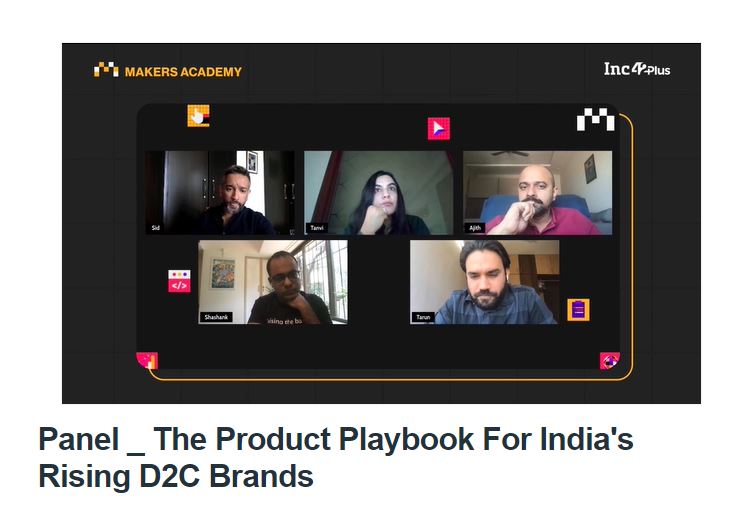Founders of popular D2C brands like Faballey, Mcaffiene, Furlenco, and The Whole Truth discussed the strategy to master the D2C game with Sid Talwar, partner at VC firm, Lightbox
They discussed how social media outreach and niche products can help to unlock new product categories
Key takeaways from the session included figuring out the right product for different markets, storytelling and customer engagement methods that help build brands and retain a loyal customer base
Direct to consumer or D2C brands are spearheading a retail revolution in India, thanks to social media. What took businesses decades of painstaking marketing and sales is now being achieved in a matter of a few months. During The Makers Summit 2021, Sid Talwar, partner, Lightbox discussed what it takes for brands to build this engagement with Tanvi Malik, cofounder of clothing brand Faballey, Tarun Sharma, cofounder and director of personal care brand Mcaffiene, Ajith Karimpana, founder and CEO of furniture subscription platform Furlenco and Shashank Mehta, founder and CEO of clean food brand The Whole Truth.
How do D2C startups know which product/ solutions they should dive into?
Twenty years ago, all personal care products in the Indian market fit into neat brackets like floral scented soaps, talcum powder and creams. But today there are a multitude of products ranging from matcha tea face serums to coffee body washes. Sharma, who has created an entire personal care product line centred around coffee as an ingredient, notes that one needs to acknowledge and follow the multiple sources of information that their user base has access to. “The information flow is so democratised that people in the UK, Mumbai and Gwalior could be consuming the same information simultaneously. So products that are popular across specific demographics can find a market fast,” said Sharma.
Further, a changing demographic (from millennial to GenZ) also creates opportunities to offer differentiated products to cater to specific activities like workouts, social engagements and outings. For instance, it is common to find an entire supermarket aisle dedicated to marathon related products like nutritional supplements and skin care products, in Western countries. Lifestyle brands in personal care products in India need to consider metrics like potential user base, skin types, use case and brand persona. Zeroing in on conversations about beauty ingredients, products and specific needs can help brands find that fit. “Online businesses can build scale but owning the discussion around the entire chain of use cases around a specific product or ingredient worked for us,” added Sharma.
All the founders who participated in the discussion were of the view that D2C startups should test their products with small pilots online as well as offline. It’s only after gauging the demand for one’s product(s) should a startup go out for scaling it up. Malik, in the discussion, emphasised upon the fact that the internet has democratised the reach, making it a different ballgame for the young D2C startups taking on the established players.
According to Malik, figuring out demographics via social media followed up with extensive user reviews and feedback helps to narrow down the “need” in the market. “Once products start selling, break down the products sold (sales data) by their characteristics in order to understand what trends are selling and plan for future demand accordingly,” added Malik.
Bringing up the issue of resource crunch for startups, Mehta said that startups need to have a D2C strategy to overcome the resource crunch while competing with the established brands. The D2C road also gives startups better control on their distribution channel, combined with social media engagement, to have control over demand and supply based on demand for the brand itself.
How Do D2C Startups Look At Product Strategy?
In Karimpana’s opinion, it is important to ensure that the product offered matches the business model or method of offering to consumers. As in the case of Furlenco, which adopted a model not very different from Netflix, for furniture. If the idea was just to sell low cost furniture, then it would not have required extensive research on how to extend the life of products. “We had to ensure that products were robust, refurbishable and reusable so that furniture could fit into the subscription model. But the idea is to make it convenient for customers without forgetting what the product is meant to do,” added Karimpana.
“A brand is a tool for storytelling,” said Mehta, initiating a topic on brand philosophy. He emphasised on the use of social media for creating an image on the mind of target customers even before the actual product(s) are launched in the market. This strategy gives greater control to startups for driving the narrative around their product. “The right storytelling helps to create a preconceived notion of the brand before the product reaches the end consumer and that is where D2C channels offer startups complete control,” Mehta added.
Sharma, on the other hand, talked about the two way communication between the brand and the users. He added that educating users about the use cases of a product is important but it’s also necessary to understand what the users need from it. Figuring out their (users’) unmet needs is where a lot of product potential comes from. “Market research provides all the initial cues required to build the solution and digital campaigns make it very easy. Involving influencers and content teams help to design products effectively and communicate it to the relevant potential users,” said Sharma.
Talking about the need to create relatable content Malik added that it was important to create culturally relevant association between the users and the products. “Use social media tools effectively to understand user engagement across categories and build recommendation engines,” said Malik.
Pointing towards the need to endorse simplicity in the message, Karimpana said that the whole idea of creating a social media engagement channel for D2C products is to keep the messaging as straightforward as possible, so that the users are able to engage without much difficulty.
A common suggestion from all the founders for the budding D2C brands was to focus on creating a niche market for their products and services. Whether it is the business model, brand story or the product itself.








![Read more about the article [The Outline] When David Acquires Goliath — India’s Age Of Startups](https://blog.digitalsevaa.com/wp-content/uploads/2021/07/indian-tech-startups-acquiring-legacy-companies--300x157.jpg)



